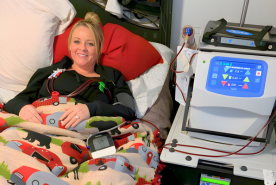Peritonitis is an infection of the peritoneum, which can occur during peritoneal dialysis. Symptoms include abdominal pain and fever. Prompt treatment is crucial.
What is peritonitis?
Peritonitis is inflammation of the peritoneum, the inside lining of your own belly that acts as a natural filter. In peritoneal dialysis, waste products are removed through the peritoneum with a cleansing fluid called dialysate, which is washed in and out of your abdominal cavity (belly) in cycles. The peritoneum has fluid and covers the organs within your belly area to protect and support them.
What causes peritonitis?
Peritonitis is usually due to a bacterial or fungal infection. The infection can happen from any rupture in the belly area, such as a burst appendix. It can also happen from any injury or trauma to belly area, or as a complication of other medical problems.
Peritonitis can also affect people on peritoneal dialysis. Improved technology and self-care methods have lowered the risk of peritonitis for people on peritoneal dialysis, but the risk for infection still remains. Therefore, if you are on peritoneal dialysis, it is important to practice good hygiene during your dialysis treatment, and to be sure to take the right steps to help reduce the risk of infection. These include washing your hands before dialysis treatment, wearing a mask during treatment, applying an antibiotic cream to the catheter exit site as often as prescribed, and other steps recommended by your healthcare team.
Is peritonitis serious?
Peritonitis can be life-threatening and may cause serious complications, depending on the cause and severity. It can also lead to sepsis, a life-threatening condition caused by the body’s reaction to an infection. Common symptoms of peritonitis can include:
- Pain in the abdomen (belly area)
- Tenderness within abdomen
- Bloating or outward expansion of the abdomen (also known as distention)
- Nausea and vomiting
- Fever
- Cloudy peritoneal fluid during peritoneal dialysis treatment
Peritonitis can be quite serious, so if you have any of these symptoms, you should seek medical help right away.
How is peritonitis diagnosed?
You will receive a physical exam for signs and symptoms. Your belly will be checked for tenderness or distention. Blood tests, X-rays, or computerized tomography (CT) scans might also be done. Some fluid will be removed for testing to confirm whether an infection is present.
How is peritonitis treated?
People with peritonitis may have to be admitted to the hospital. Treatment for a bacterial infection usually includes antibiotics given as an intravenous (IV) injection into a vein. Other supportive treatments, such as IV fluids and drugs to maintain blood pressure are given, especially if sepsis is a concern. Symptoms of sepsis can include low blood pressure, fast heart rate, fever, or difficulty breathing, so other treatments might also be needed.
Emergency surgery can also be considered, especially if a ruptured appendix or other related condition has happened. An operation may also be needed to remove damaged parts of the peritoneum.
If peritonitis happens with peritoneal dialysis then the antibiotics can be given in the peritoneal dialysis fluid. Sometimes a different form of dialysis might be needed temporarily while the body heals from the infection. If peritonitis continues or keeps returning, then peritoneal dialysis might need to be stopped and a different form of dialysis might be needed.
















